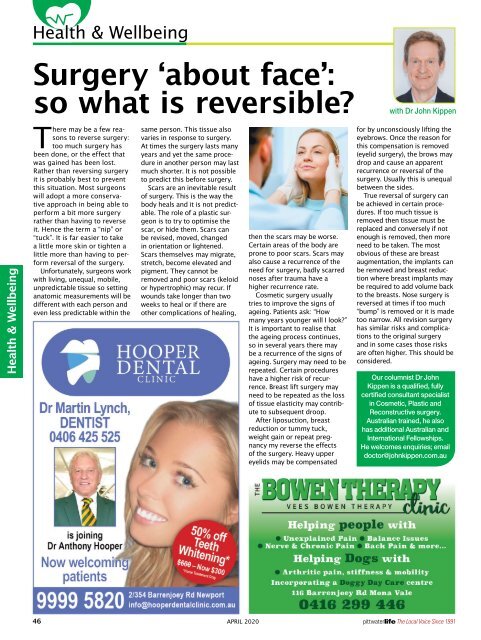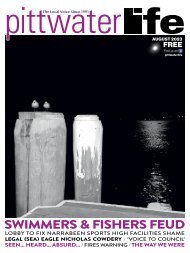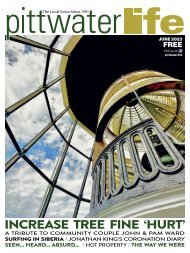Pittwater Life April 2020 Issue
Keep Calm and Stay Healthy! Shane Steadman. Offshore Gas Drilling: They Wouldn't Dare, Would They? Plus: Council's Home Solar Incentive
Keep Calm and Stay Healthy! Shane Steadman. Offshore Gas Drilling: They Wouldn't Dare, Would They? Plus: Council's Home Solar Incentive
Create successful ePaper yourself
Turn your PDF publications into a flip-book with our unique Google optimized e-Paper software.
Health & Wellbeing<br />
Health & Wellbeing<br />
Surgery ‘about face’:<br />
so what is reversible?<br />
There may be a few reasons<br />
to reverse surgery:<br />
too much surgery has<br />
been done, or the effect that<br />
was gained has been lost.<br />
Rather than reversing surgery<br />
it is probably best to prevent<br />
this situation. Most surgeons<br />
will adopt a more conservative<br />
approach in being able to<br />
perform a bit more surgery<br />
rather than having to reverse<br />
it. Hence the term a “nip” or<br />
“tuck”. It is far easier to take<br />
a little more skin or tighten a<br />
little more than having to perform<br />
reversal of the surgery.<br />
Unfortunately, surgeons work<br />
with living, unequal, mobile,<br />
unpredictable tissue so setting<br />
anatomic measurements will be<br />
different with each person and<br />
even less predictable within the<br />
same person. This tissue also<br />
varies in response to surgery.<br />
At times the surgery lasts many<br />
years and yet the same procedure<br />
in another person may last<br />
much shorter. It is not possible<br />
to predict this before surgery.<br />
Scars are an inevitable result<br />
of surgery. This is the way the<br />
body heals and it is not predictable.<br />
The role of a plastic surgeon<br />
is to try to optimise the<br />
scar, or hide them. Scars can<br />
be revised, moved, changed<br />
in orientation or lightened.<br />
Scars themselves may migrate,<br />
stretch, become elevated and<br />
pigment. They cannot be<br />
removed and poor scars (keloid<br />
or hypertrophic) may recur. If<br />
wounds take longer than two<br />
weeks to heal or if there are<br />
other complications of healing,<br />
then the scars may be worse.<br />
Certain areas of the body are<br />
prone to poor scars. Scars may<br />
also cause a recurrence of the<br />
need for surgery, badly scarred<br />
noses after trauma have a<br />
higher recurrence rate.<br />
Cosmetic surgery usually<br />
tries to improve the signs of<br />
ageing. Patients ask: “How<br />
many years younger will I look?”<br />
It is important to realise that<br />
the ageing process continues,<br />
so in several years there may<br />
be a recurrence of the signs of<br />
ageing. Surgery may need to be<br />
repeated. Certain procedures<br />
have a higher risk of recurrence.<br />
Breast lift surgery may<br />
need to be repeated as the loss<br />
of tissue elasticity may contribute<br />
to subsequent droop.<br />
After liposuction, breast<br />
reduction or tummy tuck,<br />
weight gain or repeat pregnancy<br />
my reverse the effects<br />
of the surgery. Heavy upper<br />
eyelids may be compensated<br />
with Dr John Kippen<br />
for by unconsciously lifting the<br />
eyebrows. Once the reason for<br />
this compensation is removed<br />
(eyelid surgery), the brows may<br />
drop and cause an apparent<br />
recurrence or reversal of the<br />
surgery. Usually this is unequal<br />
between the sides.<br />
True reversal of surgery can<br />
be achieved in certain procedures.<br />
If too much tissue is<br />
removed then tissue must be<br />
replaced and conversely if not<br />
enough is removed, then more<br />
need to be taken. The most<br />
obvious of these are breast<br />
augmentation, the implants can<br />
be removed and breast reduction<br />
where breast implants may<br />
be required to add volume back<br />
to the breasts. Nose surgery is<br />
reversed at times if too much<br />
“bump” is removed or it is made<br />
too narrow. All revision surgery<br />
has similar risks and complications<br />
to the original surgery<br />
and in some cases those risks<br />
are often higher. This should be<br />
considered.<br />
Our columnist Dr John<br />
Kippen is a qualified, fully<br />
certified consultant specialist<br />
in Cosmetic, Plastic and<br />
Reconstructive surgery.<br />
Australian trained, he also<br />
has additional Australian and<br />
International Fellowships.<br />
He welcomes enquiries; email<br />
doctor@johnkippen.com.au<br />
46 APRIL <strong>2020</strong><br />
The Local Voice Since 1991

















